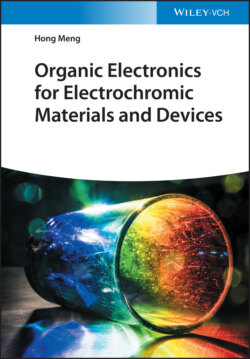Читать книгу Organic Electronics for Electrochromic Materials and Devices - Hong Meng - Страница 30
2.3.4 Ceramic Polymer Electrolytes
ОглавлениеDiffering from liquid and gel electrolytes, salt in solid‐like PEs is dissolved directly into the solid medium. It is usually a relatively high dielectric constant polymer (PEO, PMMA, PAN, polyphosphazenes, siloxanes, etc.) and a salt with low lattice energy.
Multiple advantages of using solid PEs in electrochemical cells are as follows:
1 (1) Non‐volatility.
2 (2) No decomposition at the electrodes.
3 (3) No possibility of leaks.
4 (4) Decreased cell price (such as PEO, PMMA, etc.).
5 (5) Flexibility.
6 (6) Lowering the cell weight – solid‐based cells do not need heavy steel casing.
7 (7) Safety.
Many studies have been addressed to incorporate inert oxide ceramics particles into PE, in order to improve the mechanical properties, reduce polymer crystallinity, and thus solve the problem of low ionic conductivity of solid polymeric electrolyte (SPE). For example, various composites had been mixed into polymers (see in Figure 2.9) [94], including inert ceramic fillers [95, 96], fast ion‐conductive ceramics [97, 98], lithium salts [99], IL [100], etc.
Figure 2.9 The evolutions of morphology of ceramic filler in SCEs.
Source: Li et al. [94].
By combining the advantages of these two materials, i.e. ceramic filler and polymer material, new hybrid composite materials with high dielectric constants can be fabricated. Different types of inert ceramics had been incorporated into the polymer by blending the polymers with fillers, such as SiO2 [101], Al2O3 [102], TiO2 [103], zeolite, etc. In 1982, Weston and Steele firstly prepared a composite by mixing PEO with Al2O3 [104], proving that PEO after addition of fillers exhibited an improvement of mechanical properties and ionic conductivity even in a temperature exceeding 100 °C. The idea of adding ceramic fillers into polymer complex is to provide a stable solid matrix [104]. Composite polymeric materials containing fine ceramic particles are considered as heterogeneously disordered systems [105]. Later, Capuano et al. (1991) [106] studied the effects of the doping amount and particle size of LiAlO2 powder on the conductivity of solid electrolyte. The conductivity achieved the highest after the doping amount of LiAlO2 was around 10 wt.%. In other words, particle size of the inert ceramic material influenced to the conductivity of the SPE and which increased as the size is <10 μm [107]. As was reported, Al2O3 can also effectively decrease the crystallinity and glass transition temperature of PEO, proving that the decrease of polymer crystallinity promotes the improvement of ionic conductivity [102]. Liang et al. [108] reported that PEO‐PMMA‐based composite electrolyte exhibited an improvement of the ionic conductivity from 6.71 × 10−7 to 9.39 × 10−7 S/cm, in which PEO‐PMMA and nano Al2O3 were used as a host matrix and filler, respectively [108]. Moreover, SiO2 is also a common inert ceramic filler material used in synthesizing SPE. A composite of a PEO matrix and SiO2 fillers was reported and reached an ionic conductivity of 2 × 10−4 S/cm at ambient temperature, [109] with 2.5 wt.% filler loadings. In addition, SiO2 can be designed as a three‐dimensional skeleton doped into polymers. In recent years, PEO‐Silica aerogel was reported to achieve high ionic conductivity of 6 × 10−4 S/cm and high modulus of 0.43 GPa [110]. The mechanical properties and ionic conductivity has been enhanced by controlling powder dispersion. In addition, some studies have integrated a variety of inorganic ceramics into the polymer, and the ionic conductivity has also been improved.
Fast ion conductor ceramics, also known as active inorganic electrolytes, exhibit a high ionic conductivity of up to 10−2 S/cm at 25 °C. Composite of fast ion conductor ceramics with polymer can strengthen interfacial contact. Since 2009, polymer‐in‐ceramic (PIC) approach was introduced into the field of composite polymeric electrolytes [111]. It consists of introducing polymer salt complexes into porous ceramic structures. The studied systems exhibited excellent mechanical properties, high conductivities, and good stability vs Li metal electrodes under prolonged storage [111]. As was reported recently, composite electrolytes from “ceramic‐in‐polymer” (CIP) to PIC with different sizes of garnet particles are investigated for their effectiveness in dendrite suppression [112]. With a large specific surface area, nanoscale garnet ceramic fillers improve the transition rate of ions [113]. The PIC electrolyte with 80 vol% 5 μm Li6.4La3Zr1.4Ta0.6O12 (LLZTO) (PIC‐5 μm) shows the highest tensile strength of 12.7 MPa [113]. The morphology, distribution, and three‐dimensional structure of ceramic filler particles may affect the ionic conductivity of polymer composite electrolyte [114]. Cui et al. explored the different morphologies of LLZO to increase ionic transport [115]. These LLZO nanowires show an ionic conductivity of 6.05 × 10−5 S/cm at 30 °C. A polymer–ceramic composite electrolyte of PEO and Li0.33La0.557TiO3 nanowires has been studied and exhibited the lithium‐ion conductivity of 2.4 × 10−4 S/cm at 25 °C [116]. Furthermore, glass–ceramic electrolytes are another solid ceramic electrolytes in which ions transfer through the ceramic phase by means of vacancies or interstitials within the lattice. Typical examples of this are glass/glass–ceramic Li2S‐P2S5 and ceramic thio‐lithium superionic conductor (LISICON) Li4 − xGe1 − xPxS4 (0 < x < 1), which are the most promising electrolytes to increase ion conductivity up to 10−5 S/cm [117].
The effects of ceramic fillers on the ionic conductivity of solid polymer systems have been discussed for quite many years. The published papers show that increasing the conductivity is the key parameter. Polymer‐ceramic composites offer superior mechanical properties and great conductivities. However, exploring ceramics materials is still a challenge.
